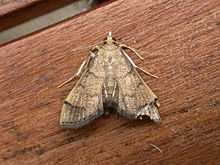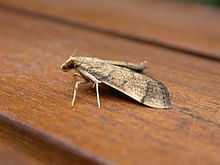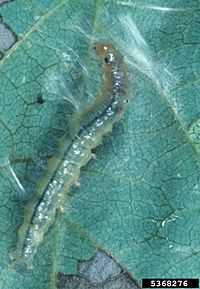Omiodes indicata
| Omiodes indicata | |
|---|---|
 | |
 | |
| Scientific classification | |
| Kingdom: | Animalia |
| Phylum: | Arthropoda |
| Class: | Insecta |
| Order: | Lepidoptera |
| Family: | Crambidae |
| Genus: | Omiodes |
| Species: | O. indicata |
| Binomial name | |
| Omiodes indicata (Fabricius, 1775)[1] | |
| Synonyms | |
| |
The Bean-leaf Webworm Moth or Soybean Leaf Folder (Omiodes indicata) is a species of moth of the Crambidae family. It is found from Florida to Texas, the West Indies and Mexico to South America,[2] Cameroon, the Comoros, the Democratic Republic of Congo, La Réunion, Madagascar, Mauritius, Nigeria, Saudi Arabia, the Seychelles, South Africa,[3] India, Borneo[4] and Australia (Queensland).


The wingspan is about 20 mm. Adults are pale brown with some dark lines and patches across the wings.[5]
The larvae feed on Arachis (including Arachis hypogaea), Beta vulgaris var. saccharifera, Calopogonium, Chrysanthemum indicum, Coleus, Gloriosa, Glycine max, Lantana camara, Nicotiana tabacum, Phaseolus (including Phaseolus vulgaris), Vigna unguiculata and Vigna vexillata. Young larvae live between two leaves spun together. Later instars may spin several leaves together. They feed on the mesophyll of the leaves but the final instar larvae completely skeletonise the leaves.[6] The larvae are pale green with a pale brown head.
References
| Wikispecies has information related to: Omiodes indicata |
| Wikimedia Commons has media related to Omiodes indicata. |